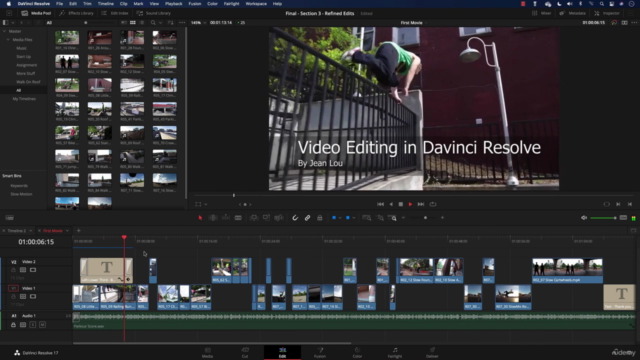
- #How to punch in on davinci resolve editing pro#
- #How to punch in on davinci resolve editing series#
Move the playhead forward 4 or so frames and adjust the Position property so the clip is up and out of the frame. Using the Position property under the Transform effect ( not Motion), toggle animation (the stopwatch) to set your first keyframe. Note: You can use the Transform effect in lieu of the Motion adjustment to create motion blur in a standard zoom as well. This will create motion blur when you animate. Then in the Effect Controls panel, uncheck “use composition shutter angle” and set it to 180. In the Effects panel, find the Transform effect and drag it to the first clip. You can hide tracks with the eyeball icon while you work. Use the Scale property in the Effect Controls panel to scale up each clip a little bit more than the last. Duplicate the clip by Option + dragging (Alt on a PC) the clip straight up in the timeline. Typically around three or four cuts will do the trick. Duplicate your clip as many times as you want the effect to zoom in. Step 1: Duplicate the Clip on the Timeline We’ll use this clip to create this effect in the example below. It’s often used as a transition effect in journalistic, investigative, or true crime content. Shutter Zoom Transition EffectĪ Shutter Zoom effect emulates a camera shutter, as though the camera is taking still photos and zooming in further on the subject for each shot. Level up with transition effects or create a visual drama with a digital dolly zoom. #How to punch in on davinci resolve editing pro#
Part 2: 3 Cool Premiere Pro Zoom Effects to Tryĭigital zooms in Adobe Premiere Pro can go beyond a simple zoom in and out. To create a zoom out, just set your first keyframes at the beginning of the clip, and adjust the Scale and Position properties so the clip is zoomed in to start.Try to Ease Out for the beginning of the movement, and Ease In for the end.To create more of a non-linear motion, select your first keyframes and right-click for a few options. You might notice the move seems to start and stop abruptly.To slow it down, move them farther apart.

To make the movement quicker, move the keyframes closer together.
Play it back in real-time and make any adjustments. New keyframes will be recorded as long as keyframing is on. Move the playhead to the spot where you want the movement to end and adjust the Scale and Position properties so you’re zoomed in and framed up around your subject. The stopwatch will be blue when keyframing is on, and any further adjustments made to those properties will be recorded via keyframe. Click the stopwatch to turn on keyframing and set a keyframe for both Scale and Position. Open the Effect Controls panel and locate the Scale and Position properties. Select a clip in your timeline and position the playhead where the movement will begin. Step 1: Set the Starting Point for Your Zoom For best results, use high-resolution video for this effect. Note: Keep in mind that zooming in will result in some loss of quality in your footage. For this example, we’ll zoom in on this clip of a coffee cup if you want to follow along! You can really quickly and easily dial up a bit, dial it down a bit, get it where you need to be in.Īlso, if client says, “I would like that bounce to be a little bit slower,” you’re not going into the keyframes, you can just drag that slider down a bit and it’s done two seconds.Digital zoom in Premiere Pro is a simple animation in which a clip is scaled up. By doing this within the “ camera shake pane” you don’t have to change lots of different key frames to get these effects. If you want it to be slightly irregular, like it’s a more organic movement, then you can do that as well. So if you want it to be regular, that’s fine, you can do that. There are all kinds of things that you can actually control: We don’t need to be shaking around everywhere, but we can just dial down the ones we don’t want and then have it moving in the direction that we do want. I’ve got all of these different controls on sliders. Solution: We use the camera shake effect. Changing the feathering and the way that things move. Problem: Previously, I’ve been trying to do this with keyframes, but I found that very frustrating due to: Occasionally, we’ll get a project where I will be working on something and I’ll just need a little bit of movement on some text or an arrow or something really simple and it isn’t worth me exporting a project, sending over to one of the animators, getting them to do it. We have dedicated team members who are animators at Still Moving Media. 

I found a great hack in BlackMagic Davinci resolve and I couldn’t wait to tell you all about it.įirst of all, I’m not an animator. Here he reveals his Camera Shake Hack which will be a slam dunk for all of you editors out there.
#How to punch in on davinci resolve editing series#
If you haven’t already seen it here’s his fantastic series Doing It All In Davinci has been immensely popular! Our friend, Dale Campbell at Still Moving Media is a wizard at Blackmagic’s Davinci resolve.







 0 kommentar(er)
0 kommentar(er)
